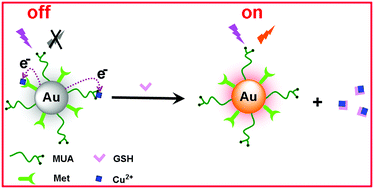Dual ligand co-functionalized fluorescent gold nanoclusters for the “turn on” sensing of glutathione in tumor cells†
Abstract
In this work, we develop a facile one-step strategy for rapidly preparing dual ligand co-functionalized fluorescent gold nanoclusters (Au NCs) and establish a “turn on” approach for the rapid and selective sensing of glutathione (GSH) in aqueous solution and living cells. The as-prepared Au NCs exhibited orange red fluorescence (λem = 608 nm), a long lifetime (5.62 μs), a large stokes shift (>300 nm), and considerable stability and were systematically characterized by using fluorescence spectroscopy, high-resolution transmission electron microscopy (HRTEM), dynamic light scattering (DLS), X-ray photoelectron spectroscopy (XPS), fluorescence lifetime, infrared (IR) spectroscopy and ultraviolet absorption spectroscopy. Based on the fluorescence recovery induced by competitive coordination with Cu2+ between Au NCs and GSH, the present “turn on” approach offers a high sensitivity and excellent selectivity toward GSH detection with a detection limit of 9.7 nM. More importantly, this “turn on” approach could also be successfully applied for visualizing and monitoring the changes in the intracellular GSH level in Hep G2 cells, providing available potential for diagnostic applications.


 Please wait while we load your content...
Please wait while we load your content...